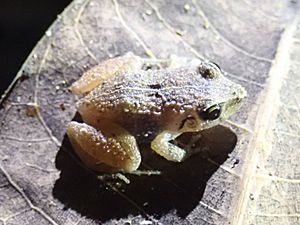Craugastor stejnegerianus facts for kids
Quick facts for kids Craugastor stejnegerianus |
|
|---|---|
 |
|
| Conservation status | |
| Scientific classification | |
| Synonyms | |
|
The Craugastor stejnegerianus is a type of frog that lives in the warm, wet parts of Central America. You can find this small frog in countries like Costa Rica and Panama. It belongs to a big family of frogs called Craugastoridae.
These frogs like to live in many different places. They can be found in dry forests, moist lowland forests, and even in cooler mountain forests. They also live in places like pastureland (fields where animals graze) and plantations (farms that grow crops like coffee or bananas). Sometimes, they even live in areas where the forest has been cut down but is slowly growing back.
Sadly, this frog is facing a challenge: its home is disappearing. This is called habitat loss. People are changing the forests and lands where these frogs live, which makes it harder for them to survive. Scientists are working to understand and protect these interesting creatures.
Contents
About the Craugastor stejnegerianus Frog
The Craugastor stejnegerianus is a fascinating frog species. It was first described by a scientist named Edward Drinker Cope in 1893. This means he was the first to officially give it its scientific name. Frogs like this one are very important to their ecosystems. They help control insects and are also food for other animals.
Where Does This Frog Live?
This frog is found only in two countries in Central America: Costa Rica and Panama. These countries are known for their rich biodiversity, which means they have many different kinds of plants and animals. The Craugastor stejnegerianus lives in various types of forests.
- Dry Forests: These forests have a dry season and a wet season.
- Moist Lowland Forests: These are warm, wet forests found closer to sea level.
- Moist Montane Forests: These are cooler, cloudier forests found on mountains.
It can also adapt to some human-changed areas. These include fields used for grazing animals and farms where crops are grown. This shows that the frog can be quite adaptable, but only up to a point.
Why Is Its Home Disappearing?
The biggest threat to the Craugastor stejnegerianus frog is habitat loss. This happens when the natural places where animals live are destroyed or changed. For these frogs, it means their forests are being cut down.
- Farming: Forests are cleared to make space for farms and plantations.
- Development: Land is used for building towns, roads, and other human structures.
- Logging: Trees are cut down for wood, which removes the frog's shelter.
When their homes are lost, frogs have fewer places to find food, hide from predators, and lay their eggs. This makes it very hard for their populations to grow or even stay the same.
What Does "Least Concern" Mean?
You might see that this frog is listed as "Least Concern" by the International Union for Conservation of Nature (IUCN). This means that, right now, scientists believe it is not in immediate danger of disappearing forever. However, "Least Concern" does not mean there are no worries. It simply means its population is not dropping very quickly yet. Scientists still watch these frogs closely. They want to make sure that habitat loss does not become a bigger problem for them in the future. Protecting their homes now is key to keeping them safe.
See also
 In Spanish: Craugastor stejnegerianus para niños
In Spanish: Craugastor stejnegerianus para niños


